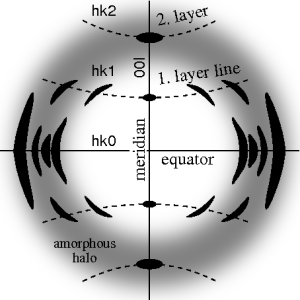Fiber diffraction
Template:Infobox scientific technique
Fiber diffraction is a powerful X-ray crystallography technique used to study the structure of fibrous proteins and other elongated biological macromolecules. It provides valuable insights into the arrangement of molecules within fibers, allowing researchers to determine the molecular structure and orientation of these complex materials.
History[edit | edit source]
The technique of fiber diffraction was first developed in the early 20th century by scientists studying the structure of fibers such as DNA and muscle proteins. Over the years, advancements in X-ray technology and data analysis have greatly improved the resolution and accuracy of fiber diffraction experiments.
Principle[edit | edit source]
In fiber diffraction, a beam of X-rays is directed at a fiber sample, resulting in a diffraction pattern that contains information about the molecular arrangement within the fiber. By analyzing the diffraction pattern, researchers can deduce the spatial organization of molecules along the fiber axis, as well as the distances between adjacent molecules.
Applications[edit | edit source]
Fiber diffraction has diverse applications in various fields, including structural biology, material science, and biophysics. It is commonly used to study the structure of fibrous proteins such as collagen and keratin, as well as synthetic fibers and nanomaterials.
Techniques[edit | edit source]
Several techniques are employed in fiber diffraction experiments to enhance the quality of data and extract meaningful structural information. These include Fourier transform, reciprocal space mapping, and molecular modeling.
Future Directions[edit | edit source]
Advancements in X-ray sources, detectors, and computational methods continue to drive innovation in fiber diffraction research. Future developments may lead to higher resolution structures and new insights into the behavior of complex fibrous materials.
See also[edit | edit source]
Search WikiMD
Ad.Tired of being Overweight? Try W8MD's physician weight loss program.
Semaglutide (Ozempic / Wegovy and Tirzepatide (Mounjaro / Zepbound) available.
Advertise on WikiMD
|
WikiMD's Wellness Encyclopedia |
| Let Food Be Thy Medicine Medicine Thy Food - Hippocrates |
Translate this page: - East Asian
中文,
日本,
한국어,
South Asian
हिन्दी,
தமிழ்,
తెలుగు,
Urdu,
ಕನ್ನಡ,
Southeast Asian
Indonesian,
Vietnamese,
Thai,
မြန်မာဘာသာ,
বাংলা
European
español,
Deutsch,
français,
Greek,
português do Brasil,
polski,
română,
русский,
Nederlands,
norsk,
svenska,
suomi,
Italian
Middle Eastern & African
عربى,
Turkish,
Persian,
Hebrew,
Afrikaans,
isiZulu,
Kiswahili,
Other
Bulgarian,
Hungarian,
Czech,
Swedish,
മലയാളം,
मराठी,
ਪੰਜਾਬੀ,
ગુજરાતી,
Portuguese,
Ukrainian
Medical Disclaimer: WikiMD is not a substitute for professional medical advice. The information on WikiMD is provided as an information resource only, may be incorrect, outdated or misleading, and is not to be used or relied on for any diagnostic or treatment purposes. Please consult your health care provider before making any healthcare decisions or for guidance about a specific medical condition. WikiMD expressly disclaims responsibility, and shall have no liability, for any damages, loss, injury, or liability whatsoever suffered as a result of your reliance on the information contained in this site. By visiting this site you agree to the foregoing terms and conditions, which may from time to time be changed or supplemented by WikiMD. If you do not agree to the foregoing terms and conditions, you should not enter or use this site. See full disclaimer.
Credits:Most images are courtesy of Wikimedia commons, and templates, categories Wikipedia, licensed under CC BY SA or similar.
Contributors: Prab R. Tumpati, MD

